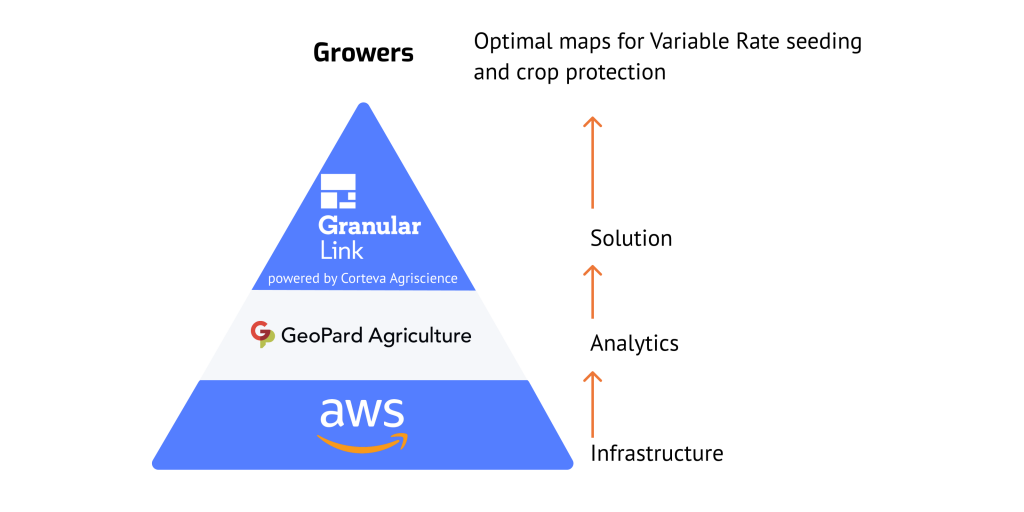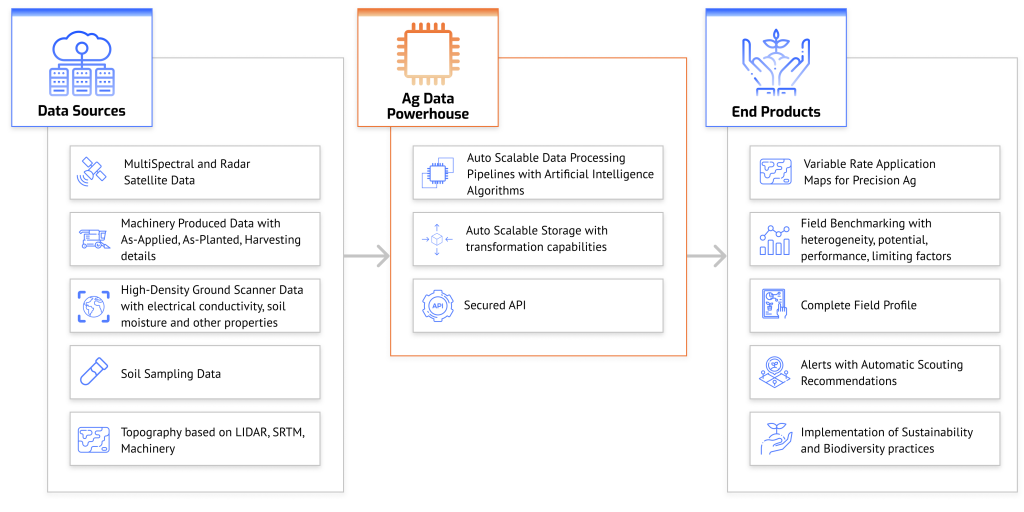AWS Startups Blog
Improving the Sustainability of Crop Farming Using a Data-driven Approach
Guest post by Dzmitry Yablonski, CTO and Co-Founder of GeoPard Agriculture
Due to the effects of advancing climate change and a growing global population, agricultural professionals are under more pressure than ever before to produce higher yields with fewer inputs. On one hand, the world’s population is expected to increase by 2 billion in the next 30 years according to United Nations statistics, whilst at the same time water, land, labor, and other resources for food production are expected to become scarcer. According to the US Environmental Protection Agency, 24% of all Greenhouse Gas (GHG) emissions originate from agriculture, and action to reduce emission is becoming more and more critical. Meanwhile, COVID-19 remains a challenge. Collaboration between Ag Tech companies is as essential as ever to speed up the delivery of the technologies to the crop growers.
Let’s learn how Geopard, an independent precision agriculture platform, collaborates with Corteva, a leading global agricultural input company, to enhance the capabilities of their Granular™ Link App.
The Business Case
As a major agricultural company, Corteva Agriscience understands the challenges facing humanity such as climate change, preserving biodiversity, and meeting the increasing demand for food. Sustainable crop farming and biodiversity are integrated into the strategic vision. In Europe, they are continuously increasing the suite of digital solutions to improve the efficiency of agronomic decisions via more smart usage of agricultural inputs.
This year, Corteva Agriscience Europe launched a new product – Granular™ Link with a tailored Variable Rate Application (VRA) maps. This app augments the company’s physical products (seed and crop protection) with smart recommendations integrated into a decision support tool. That represents an integrated set of digital ag features at the field level to reduce risk and maximize yields. Granular™ Link provides:
- Best-in-class satellite imagery;
- Variable-rate maps and integration with machinery;
- Optimal harvest date prediction;
- Crop disease prediction;
- Water needs recommendations;
- Photo observation and field notes;
- Hyper-local field weather forecast;
- Computer vision disease identification;
- And a collaboration platform at field level for farmers and Corteva advisors.
From the first day of Granular™ Link, Flavio Cozzoli, Head of Digital Agronomy and Innovation at Corteva Agriscience Europe, and his team faced multiple challenges that needed to be overcome for a successful commercial rollout. Data sources are inconsistent with each other, and the amount of available data is constantly growing to reach hundreds of terabytes. They required an engine to generate consistent VRA maps at the scale of millions of hectares at the load peaks in minutes. There is also the challenge of the agricultural timeline, where skipping a single crop season could affect the annual plan to validate technologies.

This is where GeoPard Agriculture stepped in to help and collaborate with Corteva Agriscience by providing high-quality, powerful, and scalable data analytics. GeoPard founder’s reputation preceded them: ex-Zoner and a precision agriculture web-based software acquired by Bayer Crop Science in 2015, ex-Xarvio and first internal software engineers/technical managers there.
The Granular™ Link solution combines the GeoPard Agriculture geoanalytics capabilities, unique knowledge about own products and best-suitable agronomic practices, and the secure scalable infrastructure from AWS to deliver the state-of-the-art technology to growers in the EU.
Our Approach
An agricultural field is a complex multifactorial ecosystem. It includes a variable soil profile with its micro- and macro-nutrients, physical and chemical properties, weather conditions, crop varieties, detailed topography profile, and executed agricultural operations. A single data layer is never enough to accurately describe the crop growth processes. Therefore, GeoPard collects multiple, various data layers and produces insights out of them in an automatically scaled manner over millions of hectares. In the end, the resulting knowledge improves crop production practices, integrates precision agriculture, and enables remote crop monitoring and the transition to data-driven and sustainable agriculture.

The range of available data sources is continuously growing. At the moment, data is produced by:
- Satellites, manned aircraft, drones taking into consideration the physical characteristics of installed sensors;
- Machinery adopted for precise applying of agricultural inputs (Variable Rate Technology);
- High-density scanners;
- Laboratory soil samples.
Harmonizing data sources enables further Artificial Intelligence (AI) modeling and human interpretation in an effective way. An understanding of the specific farming systems is essential. The GeoPard team understands the differences inside countries and regions exist. And therefore we treat each of them as a unique entity with its own established farming processes.
Scalability and maturity are inherent characteristics of GeoPard’s offerings. From day one, the team has focused on the cost-efficient and auto-scalable utilization of AWS cloud computing capabilities.
Customer service is not only tailoring the solutions to specific requested agronomic rules; it also includes incorporation into regular processes and flexible integration into existing digital solutions.
Data Sources
Data Sources are the starting point for building any data platform. They are various by nature and include satellite imagery, topography, high-density scanners, and machinery-logged operational data.
Originally, Geopard started with its automated satellite imagery pipeline. The primary focus initially was on multispectral imagery from Landsat4-8 and Sentinel2 missions with historical archives since 1988. Understanding the past vegetation and correlating it to yield, weather and soils provides an excellent tool to understand field variability and predict yield. Extending the satellite imagery suite with Planet, the largest earth observation satellite network delivering a near-daily global dataset with high-resolution data, was the next straightforward step. Meanwhile, the suite is constantly growing and now it is expanding with Synthetic Aperture Radar (SAR) imagery from the Sentinel1 mission.
The comprehensive profile of the field landscape can explain crop vegetation patterns. This can be collected either using remote sensing or machinery-logged GPS data. Among remote sensing sources, there are Aster and SRTM missions and high-resolution LIDAR.
Data collected from sensors on ground machinery mirrors the accuracy of applied agricultural inputs. It represents details of harvesting, spraying, planting/seeding, and fertilizing operations executed in the field. The range of high-density soil scanners is also expanding. Soil sensors can measure much more than electrical conductivity and soil moisture, but also collect data about micro and macro-nutrients. That’s how the soil scanners are becoming the alternative to classic soil sampling probes. The major benefits are continuous field coverage (comparing to selected locations) and scanning frequency (easier to have up-to-date soil conditions).
Data flows are continuous as GeoPard receives data every day. However, raw data is also not enough to make reasonable data-driven decisions. Additional processing is required to produce useful and meaningful results. Extracting knowledge and insights from the acquired data at a large scale is a major challenge for the agriculture industry.
A Powerhouse for Agricultural Data
Technically, the GeoPard powerhouse contains 3 main components: data processing pipelines, data lake, and secured interfaces. It processes the raw original data to produce harmonized datasets and enables both artificial intelligence and agriculture professionals to undertake efficient data exploration and analysis.

The data processing pipelines run in an auto-scalable manner. As many computing resources as needed are rented from AWS during load peaks, and then they are released back once the processing is finished. Artificial Intelligence (AI) and Machine Learning (ML) algorithms are incorporated into the execution of data pipelines.
Data storage is based on the AWS Data Lake approach which stores the data and allows scalable access to it. There are no limitations linked to data size and simultaneous read/write capacity. The storage easily supports terabytes of the data for simultaneous saving (write) and extraction (read) operations. In addition, capabilities of on-demand transformations across various formats are available to simplify integration with any solution.
Secured interfaces for interaction with GeoPard are built on top of Amazon API Gateway, AWS AppSync, and Amazon Cognito. It enables seamless communication with internal and external applications and platforms.
End Products
The GeoPards End Products are part of a greater data-driven revolution in agriculture. They enable the easier/faster integration of precision agriculture technologies. In turn, the precision ag speeds up the transition to sustainable crop farming.
Precision agriculture is a farm management concept based on observing, measuring, and responding to inter and intra agricultural field variability in crops. In particular, field benchmarking helps track the seasonal performance of crops, measure the historical heterogeneity and productivity, and prioritize in-season activities such as harvesting or spraying chemicals.
Smart scouting and sampling assist with the correct detection of locations to visit and to execute the needed measurements and collect samples. Variable Rate Application maps enable the application of the exact amount of inputs to the exact locations where the inputs are required- and only to those locations.
Rich biodiversity and ecosystem balance can be achieved via the use of optimized crop rotations with increasing carbon sequestration and decreasing GHG emissions.
All of these features are available on a large scale measurable over millions of hectares. From day one, we at GeoPard recognized the intensively growing amount of coming data over the next decade. And the cloud foundation based on the most effective AWS approaches (like Data Lake and State Machine) was established to afford excellent scaling capabilities.
Conclusion
By 2050 the world will need to feed an additional 2 billion people using fewer inputs than at present in a more sustainable manner. In terms of climate change, the clock is ticking, placing pressure on the agricultural industry to take immediate action. To make a successful transformation, collaboration between companies is vital. Creating and maintaining synergies between data and cloud computing providers like AWS, precision ag software companies, agricultural input corporations, combined with solutions-based and consulting services, is the most promising avenue for a fast transformation.
 Dzmitry Yablonski is CTO & Co-founder at GeoPard Agriculture, former Bayer CropScience/Xarvio Tech Manager, and engineering digital solutions in Precision Agriculture during the past 10+ years. In his spare time he loves playing basketball.
Dzmitry Yablonski is CTO & Co-founder at GeoPard Agriculture, former Bayer CropScience/Xarvio Tech Manager, and engineering digital solutions in Precision Agriculture during the past 10+ years. In his spare time he loves playing basketball.